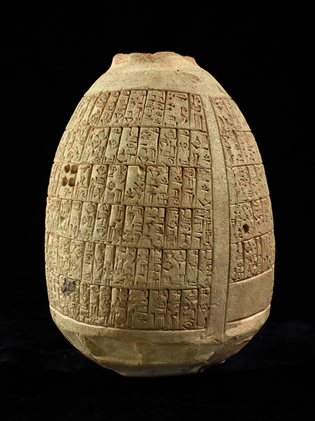
Carl Kaufman
A 4,000-year-old clay urn in Yale's collections documents a Mesopotamian war--and features the first record of the use of compound interest.
View full image
One of the many fascinating objects on display in the newly reopened Peabody Museum is an extraordinary 4,000-year-old document: the Umma-Lagash cone. It’s a hollow ceramic vessel—about the size and shape of an American football—that was made for Enmetena, king of the Sumerian city-state of Lagash. The king, who lived sometime around 2400 BCE, had the vessel made to memorialize his conquest of Umma, a neighboring kingdom. The text that spirals around the urn celebrates the recovery of canals and barley fields that had long been disputed between the two cities. It is the oldest known historical record of a diplomatic treaty and the earliest record of a war.
Large-scale, literate urban civilization in southern Mesopotamia emerged roughly 5,000 years ago on the land between the Tigris and Euphrates rivers. Early cities in what is now southern Iraq relied almost entirely on irrigated agriculture, and their canal systems were vital. Control over water rights and access was what led to the war between Umma and Lagash.
Enmetena claimed that Umma’s king had usurped an agreement his uncle Eanatum made with Umma’s ruler decades earlier, about the use of canals and control of the fields they fed. The treaty seems like an agreement to pay tribute in exchange for land use:
Eanatum, ruler of Lagash, uncle of Enmetena ruler of Lagash, demarcated the border with Enakale, ruler of Umma. He extended the [boundary-]channel from the Nun-canal to the Gu’edena, leaving 25 nindan of Ningirsu’s land under Umma’s control and establishing a no-man’s land there. . . . The leader of Umma could exploit one guru [300 liters] of the barley of Nanshe and [one guru of] the barley of Ningirsu as a[n interest-bearing] loan.
A later ruler of Umma—Urluma—broke the treaty:
He set fire to their monuments and smashed them, and destroyed the established chapels of the gods that were built on the [boundary-levee called] Namnundakigara. He recruited foreigners and transgressed the boundary-
channel of Ningirsu. Enanatum, ruler of Lagash, fought him in . . . the field of Ningirsu. Enmetena, beloved son of Enanatum, defeated him. Urluma escaped, but was killed in Umma itself [and] left the bones of their personnel strewn over the plain. He [Enmetena] made burial mounds in five places there for them.
Not satisfied after regaining the fields, Enmetena also demanded war reparations, claiming that 8.64 million guru in unpaid rent had accrued. This astronomically large number stands out on the cone as a set of big, round marks, visible in the photograph.
How could two guru of barley grow into 8.64 million guru—74,290,269 bushels, by today’s measure? The answer: compound interest. The document compounds the unpaid balance for generations at 33 and one-third percent, to arrive at an impossibly large reparations bill that, in effect, put Umma perpetually in Lagash’s debt. Enmetena’s cone is thus also a milestone in the history of finance: the first record of the use of compound interest.
But while the math was solid, the logic was not. The disputed fields would never have yielded that much grain; the fields would have had to grow exponentially with the unpaid grain balance. Financial mathematics was, in this case, a rhetorical device to justify subjugating a neighboring kingdom.
The shape of the cone is itself interesting. You have to hold and rotate it around and around to read it. The bottom of the cone is shaped like a net. Scholars have suggested that this symbolizes a warning and a curse at the end of the document:
If the leader of Umma transgresses the boundary-channel of Ningirsu and . . . of Nanshe, to take away fields by force—whether he be the leader of Umma or an[y] other leader—may Enlil destroy him! May Ningirsu, after casting his great battle-net upon him, bring down upon him his giant hands and feet!
Irrigated fields and canals still surround the remains of the cities of Umma and Lagash. A major canal, the Shatt al-Gharraf, runs between the two sites. It is an important source of water for irrigation to this day.
On your next visit to the Peabody, stop in to see a document unique in the history of human conflict and unique in the history of finance.
 loading
loading
1 comment
-

Henny Wright '78, 10:34am September 17 2024 |  Flag as inappropriate
Flag as inappropriate
The comment period has expired.That's fascinating! Makes me want to make a stop in New Haven.